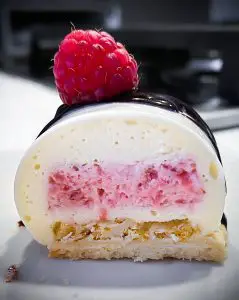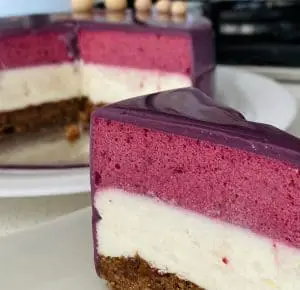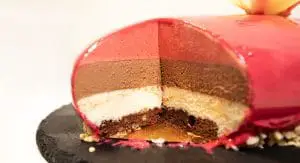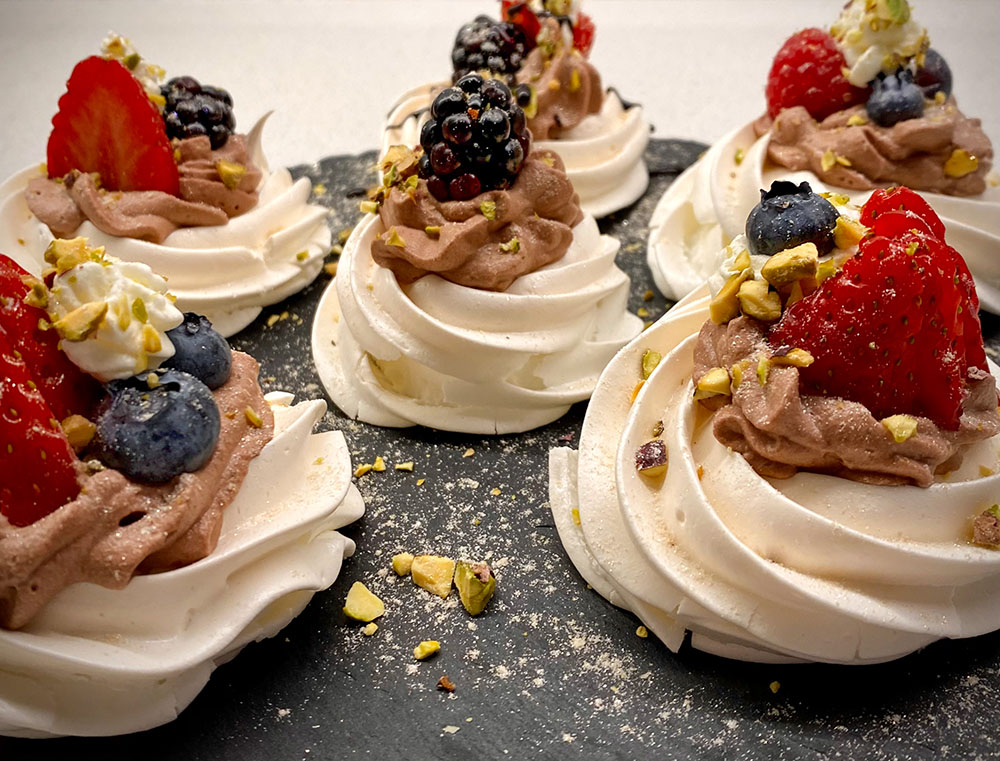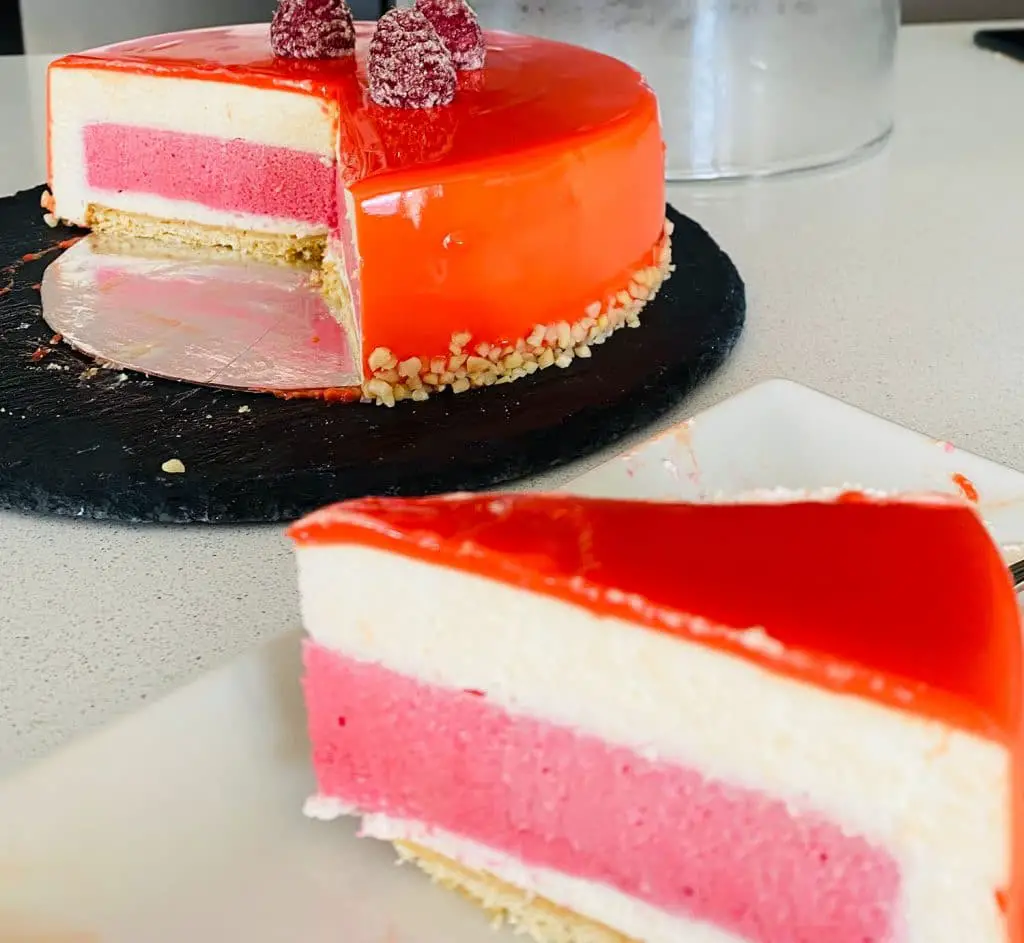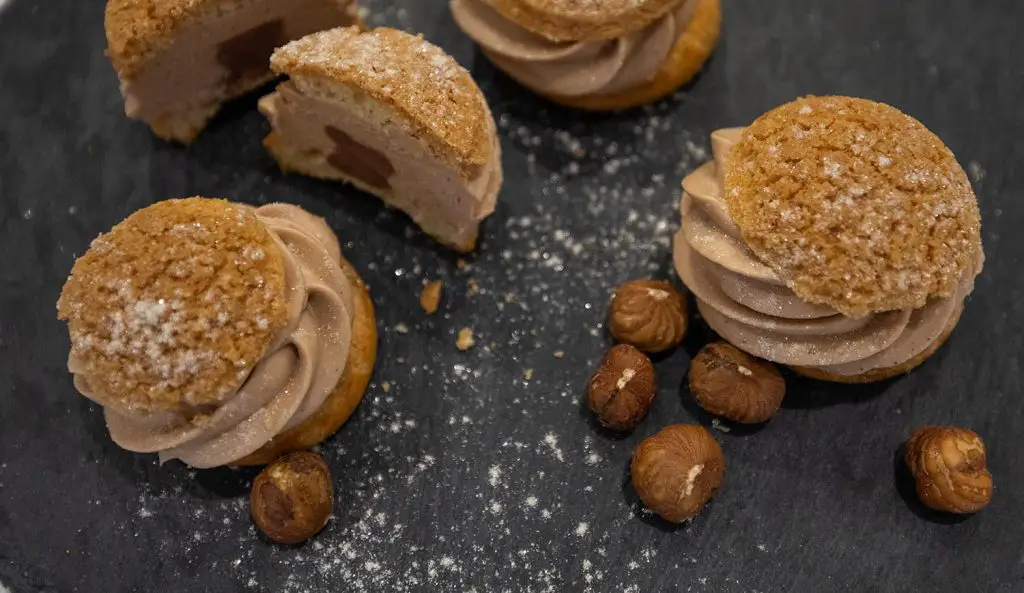Talking about wobbling jellies, fluffy and light mousses, foamy marshmallows and plenty of other exquisite desserts, it is almost impossible not to take a closer look at gelatin – their key ingredient.
What Is Gelatin?
Gelatin is a thickening agent that converts a liquid into a solid. It is used more often than others in confectionery. Gelatine is used to get a fluffy and firm consistency in mousses, different types of desserts or ice cream. Therefore, it ensures their tempting melting-in-the-mouth sensation. It is also added to fillings, souses, creams, jellys and cheesecakes.
Gelatin is a natural protein taken from animal sources. Moistened (bloomed) gelatin has melted gummy texture and can be incorporated into a dessert. Adding to liquid cause molecules dispersion and protein molecules are spreading throughout. As the mixture cools down, protein molecules start to interlink with each other, getting shape of a three-dimensional net, with captured molecules of water inside. It gives a dessert relatively stable and firm texture, liquid ingredients loose their ability to flow and a mousse or jelly is formed.
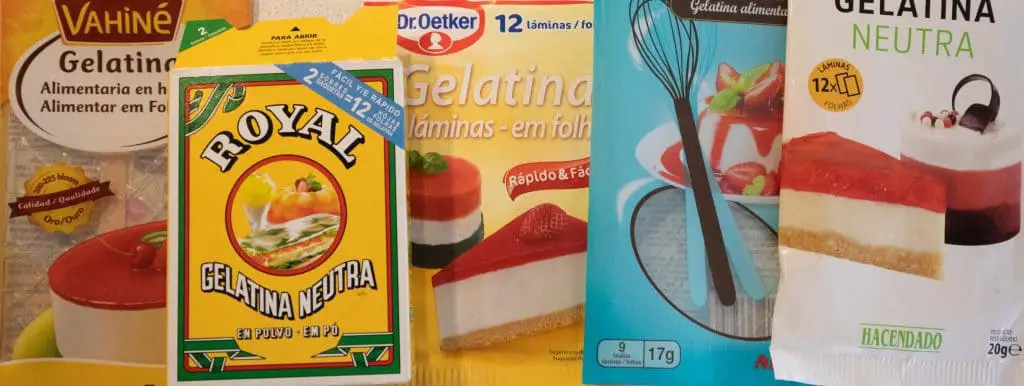
How and What Is Gelatin Made of?
Gelatin is extracted from collagen-rich animal bones, hides and joins. Commonly commercial production of gelatin is based on processing cattle bones and pork hides. There are some differences in manufacturing techniques, hides are processed in acid and bones need an alkali treatment. As with many other products, different steps in processing can give different grades of the final product, from finest to average. Finest gelatin is valued for its transparency, lack of pronounced flavour and odor and gelling strength, which is based on its high molecular density.
In general, porcine gelatin is more colorless and transparent, also has some light odor, while bovine gelatin is a bit darker but less aromatic.
Benefits Of Gelatin
Gelatin has some unique properties which make it a key ingredient:
- It forms a thermo-reversible gel
- It is colorless and transparent
- It is a natural protein
- It melts at body temperature
That’s why gelatin is one of the most commonly used thickening agents in pastry. Others are agar, pectin, starch, xanthan gum, tara gum, alginates, carrageenan, etc.
Properties Of Gelatin
- Gelatin 85-90% consists of collagen protein, which is produced from pork or bovine skin and bones. Available in powder or sheet form.
- Gelatin starts to work in a hot liquid (above 50 C). It won’t be activated without preheating. For example, if you add gelatin to a cold or slightly warm cream, it will not dissolve in the mass, and it will not solidify.
- Gelatin stabilizes at temperatures below 15 C. If you leave the jelly in the room, it will never solidify. Therefore, we send fillings and cakes to the refrigerator or freezer for stabilization. The same goes for storing desserts. If you leave the mousse cake at room temperature, it will become soft, may lose its shape and even flow (free water will leak out, but this happens very rarely. Usually due to a violation of the cooking technology). Therefore, the storage temperature of cakes and desserts is not higher than +15 C, which means they must be stored in a refrigerator.
- Visible signs of gelation appear pretty quickly when the jelly is cooled. But It is important to keep in mind that the maximum strength and stability occurs after 12 hours. That’s why cake fillings, cheesecakes and mousses are always prepared in advance.
- Gelatin is thermally reversible. If you melt it and then cool it, it will become hard and can be melted again. We use this property when we add gelatin to hot liquid. Or let’s look at the property of thermal reversibility from the other side. If we froze the cake and then warm it to room temperature. In this case, freezing will not deprive the gelatin of its properties, the dessert will remain in a stable solid state. The main thing is not to heat it back to 50 C, otherwise it will become liquid.
- Fatty milk products such as cream or buttermilk must not be frozen, as they will separate into water and fat. And if you make mousse or cheesecake with gelatin from them, then everything will turn out great. Phase separation will not occur.
- The filling with gelatin melts at temperatures above 35 C, as soon as a piece of jelly comes into the mouth. Unlike marmalade stabilized by agar, which remains firm. This important feature allows us to create more tender and ‘mouth melting’ desserts.
- Gelatin is a natural macromolecule protein, contains no gluten, cholesterol, fat or carbohydrates. Its amino acids are valuable for health. Gelatin helps to improve skin texture and may reduce joint and bone pain.
Types Of Gelatin: Sheets Vs Powder
Gelatin for cooking is available in powder and sheets (leafs).

Gelatin Sheets
Sheet gelatin – pressed transparent brittle sheets, size and weight may vary.
- Usually weaker than powdered gelatin. Sheets may vary in bloom rating, usually from 130 to 220 (“bronze”, “silver” and “gold” gelatin)
- Can be soaked in any amount of cold water
- Sheets are easy to count, there is no need to use scales.
- Sold at any grocery store, available in online shops
- A bit more expensive than powdered gelatin
How to soak gelatine leaves?
If you’re using gelatin sheets, soak them in a cold water for appx. 10 minutes. In that time, they will transform from a brittle, translucent leaf to a gummy, soft membrane resembling contact lenses.
If you need to soak multiple sheets of gelatin, it is better to separate them — they are delicate and tear easily. To avoid sticking and tearing, lay them one by one in a bowl filled with cold water.
Before adding bloomed sheet gelatin into your recipe, gently squeeze the softened leafs from excess of water. If they meant to be added to a cold base, heat them in a saucepan over low heat, or giving short impulses in microwave, until they dissolve, then mix into the preparation.
Instant Gelatine Powder
- Usually stronger than sheet gelatin, usually has a bloom rating of about 230
- Soaked in a ratio of 1 part gelatin to 6 parts water
- For large production, it is easier to weigh gelatin powder than to count sheets.
- A bit cheaper than sheet gelatin
- Sold at any grocery store, available in online shops
How do you soak gelatin powder?
Powdered gelatin is a little more difficult to work with. You need to accurately measure the amount of water. Soak gelatin powder in water in a ratio of 1: 6. For example, the recipe uses 5 g of powdered gelatin, which means you need 5 * 6 = 30 g of water. Pour powder into a container, then pour cold water. The gelatin will absorb all the water: not a drop will remain. The swollen gelatin will be a loose mass. We add it to the hot liquid.
Strength Of Gelatin, Bloom Rate
The higher the Bloom value, the stronger the gel becomes. Also, the higher the strength of the gelatin, the faster it hardens, the color becomes lighter and the taste is less notable. Usually low bloom gelatin has a dark color and a meaty aftertaste.
Manufacturers have their own bloom ranges of strength, but generally it is from 80 to 300 bloom.
Generally, one envelope of powdered gelatin equals 4 sheets of 225-bloom-strength sheet gelatin.
Usually in the recipes of pastry chefs, gelatin with a strength of 200-220 Bloom is often used.
Gelatin Bloom Strength
Talking about gelatin the term “bloom” has two meanings.
- The strength of gel is measured in blooms. The higher the bloom number – the stronger is gelatin. High bloom gelatin set faster.
- Blooming means soaking gelatin in water. This process is needed to soften gelatin before it will be added to other ingredients.
Powdered gelatin normally has a rating of about 230 bloom (it is normally specified on a package).
Sheet or leaf gelatin usually has different bloom ratings. And here is a trick to understand.
The gelling power per sheet should be the same regardless of the bloom rating, that’s why sheets with lower bloom numbers are bigger and weigh a bit more.

Commonly, manufacturers mark gelatin as “bronze”, “silver”, “gold”, “platinum”. Leafs or sheets are available in weight ranging from 1.7gr to 3.3gr.
Generally, it looks like this:
| Label | Bloom | Weight per Sheet |
|---|---|---|
| Bronze | 130-160 bloom | 3,3g (1.16oz) per sheet |
| Silver | 160- 200 bloom | 2,5g (0.88oz) per sheet |
| Gold | 200-230 bloom | 2g (0.7oz) per sheet |
| Platinum | 240-260 bloom | 1,7g (0.6 oz) per sheet |
Bloom ratings of leaf gelatin
As it was mentioned before, powdered and sheet gelatin will commonly have different gelling power, so equal weights of powdered and leaf forms can’t be replaced by each other directly.
To substitute powder to sheet gelatin following scaling can be used:
1 teaspoon of powdered gelatin (weight is about 2.8g) has the same gelling power as 2 sheets of gelatin.
What Is Gelatin Mass?
There are some recipes that indicate not the weight of gelatin, but the weight of the gelatin mass. Gelatinous mass is pre-stabilized gelatin with water. That is, the gelatin was soaked in advance, it swelled, we melt it, pour it into a mold and cool it. It turns out a layer of gelatin. Cut off the required amount from it and dissolve it in hot liquid. The gelatinous mass is stored in the refrigerator for 5-7 days.
When you need to cook a large number of cakes, it is very convenient to prepare the gelatinous mass in advance. Instead of separately soaking gelatin for each component, soak the entire volume of gelatin at once, prepare the gelatinous mass and cut off the required amount. This saves time and dishes (less staining, less washing).
How To Prepare Gelatine Mass?
To prepare gelatin mass you need to dissolve soaked (bloomed)n gelatin in water.
Amount of gelatin = 1/7 of the gelatinous mass (in some recipes ⅕)
For example, the recipe indicates 105 g of gelatinous mass. To calculate how much gelatin is required, divide the mass into its components: 1 part of gelatin + 6 parts of water = 7 parts of gelatinous mass.
So gelatin is needed 105/7 = 15 g
Be sure to check the calculations: 15 g of gelatin + 15 * 6 g of water = 105 g of gelatinous mass.
Dessert Ingredients That Influence Gelatine Gelling
- A high concentration of sugar or salt slows down the hydration and dissolution of gelatin. They bind water, so gelatin must compete for free water. However, sucrose and sugar alcohols such as sorbitol help to stabilize gelatin gels, while increasing the setting time and melting point.
- Fats can soften and make gels look like plasticine. In this case, more gelatin may be required. On the other hand, foods that contain fats (such as cocoa butter) require less gelatin. For example, dark chocolate ganache mousse does not require gelatin stabilization. The structure is supported by plenty of cocoa butter.
- Gelatin is a protein that is broken down by enzymes (enzymes). Pineapple, figs, kiwi, melon, dates contain these enzymes. If your recipe uses puree or fruit pieces, bring the puree to a boil first. The enzymes will break down and gelatin can be added.
- If you use ready-made professional puree, then such a procedure can be omitted, since the mashed potatoes were pasteurized in the production and the enzymes have already been destroyed.
- Alcohol can also affect gelling process. High-proof spirits not only prevent the gelatin access to water for hydration, direct exposure to alcohol may denature the proteins, making them useless.
- Acidic ingredients. The acidic treatment which is used in porcine gelatin production makes it more vulnerable to solutions with a pH of 3 or lower. Most desserts aren’t that acidic, but some ingredients like lime, lemon, passion fruit, rhubarb, and even some forest fruits are. If gelatin and acidic fruit juice are put into direct contact, the texture of a dessert may suffer, especially in recipes that call for only a small amount of gelatin, like panna cotta or mousse.
Can gelatin be heated above 100 °C (212°F)?
Some recipes and back-of-the-box directions call for boiling water, that might give us the impression that gelatin is insensitive to high heat, but actually boiling ris its upper limit. Gelatin’s strength begin to decline rapidly above 212°F, or when it’s held at that temperature for an some time. Mostly, effect of the heat impacts rigidity, not viscosity, which explains how gelatin can still be added to slow-cooked dishes like pasta Bolognese. In sufficient concentration, even damaged gelatin can can still have remarkable power, but it is barely enough to stabilize a dessert and the texture may significantly alter.
Gelatins vulnerability to heat may be increased or decreased by presence of acidic ingredients. So without overcomplicating things, it is better always to let the mixture cool a bit before adding bloomed gelatin. For example marshmallows recipe calls for a sugar syrup cooked to an excess of 121°C (250°F), it is reasonable to cool the syrop to 212°F before adding gelatin, otherwise the texture of a final product may result gooey and undesirably soft.
Tips And Tricks From The Professionals
Creating dishes with perfect texture:
- Never boil gelatine with liquids as it will lose its gelling power otherwise.
- When mixing into cold preparations, the cold mixture should be added to the gelatine solution and not vice versa.
- Gelatine for cold dishes may be easily dissolved in the microwave. To do so, place squeezed-out gelatine in a small bowl in a microwave and allow to liquefy for about 10 seconds at full power.
- For jellies with exotic fruits, like kiwis, pineapples, papayas or mango briefly steam the fruit before preparation or simply pour hot water over the fruit. In their raw state they contain enzymes which split protein, and the gelatine would otherwise lose its gelling power.
Making sure gelatine dishes have a nice shape:
- Moulds for gelatine dishes should not have a capacity/content of more than 1,5 litres. Otherwise, when they are turned dishes could collapse due to their weight.
- Moulds made of silicone, glass, white plastic or ceramic are particularly suited to the preparation of gelatine dishes.
Correct storage before consumption:
- Do not freeze jellies as these lose their creamy consistency after defrosting.
- Always store gelatine in a dry and odour-neutral place so that it does not absorb any moisture or odours.
More pastry techniques and recipes:


